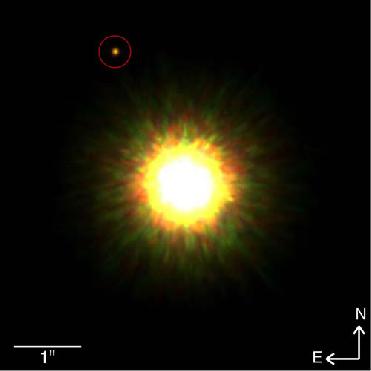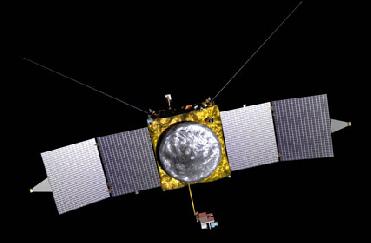
WASHINGON, DC (BNS): The first picture of a planet orbiting a normal star similar to the Sun, outside the solar system, was unveiled Monday.
Till now, planet-like bodies seen directly outside the solar system, are either free-floating in space, and not found around a star, or are orbit brown dwarfs, which are dim and make it easier to detect planetary-mass companions.
Using the Gemini North telescope on Mauna Kea in Hawaii, three University of Toronto scientists took pictures of the young star 1RXS J160929.1-210524, which lies about 500 light-years from Earth, and is also known to be a companion of that star.
The astronomers also obtained spectra to confirm the nature of the companion, which has a mass about eight times that of Jupiter, and lies roughly 330 times the Earth-Sun distance away from its star. It is said that the parent star is similar in mass to the Sun, but is much younger. In comparison, the most distant planet in the solar system, Neptune, orbits the Sun at only about 30 times the Earth-Sun distance.
Describing the finding, David Lafrenière, lead author of the project said that this was the first time that one had directly seen a planetary mass object in a likely orbit around a star like the Sun. “If we confirm that this object is indeed gravitationally tied to the star, it will be a major step forward,” Lafrenière said, whose findings are available online and will also be appearing in the Astrophysical Journal of Letters.
According to them, the existence of a planetary-mass companion from its parent star comes as a surprise, and also poses a challenge to theoretical models of star and planet formation.
Another team member part of the study, Ray Jayawardhana said that this discovery was yet another reminder of the truly remarkable diversity of worlds in outer space, and a strong hint that nature may have more than one mechanism for producing planetary mass companions to normal stars. Jayawardhana is also writing a book on extra solar planets titled, ‘Worlds Beyond’.
The astronomers stumbled upon the startling discovery by utilizing Gemini observations of adaptive optics technology to dramatically reduce distortions caused by turbulence in the Earth’s atmosphere. The scientists arrived at the opinion with the near-infrared images and spectra of the suspected planetary object that it is too cool to be a star or even a more massive brown dwarf, and that it is young. “Taken together, such findings confirm that it is a very young, very low-mass object at roughly the same distance from Earth as the star,” they said.
Explaining the discovery, the team said that even though the likelihood of a chance alignment between such an object and a similarly young star is rather small, however, it will take up to two years to clarify that the star and its likely planet are moving through space together. “Of course it would be premature to say that the object is definitely orbiting this star, but the evidence is extremely compelling. This will be a very intensely studied object for the next few years,” Lafrenière said.
On the team’s search method, Marten van Kerkwijk said that they targeted young stars so that any planetary mass object they hosted would not have had any time to cool, and thus would still be relatively bright. “This is one reason, we were able to see it at all,” Kerwijk said.
Describing the discovery they said that the Jupiter-sized body had an estimated
temperature of about 1800 Kelvin, nearly about 1500ºC, much hotter than Jupiter, which has a temperature of about 160 Kelvin, nearly -110ºC, and probably hosts a young star of type K7 with an estimated mass of about 85 per cent that of the Sun.
The team said that a survey of more than 85 stars in the Upper Scorpius association, a group of young stars formed about 5 million years ago, lead to the discovery. They said that by using the Gemini telescope's high-resolution adaptive optics capabilities, they were able to determine the different types of companions that can form around young stars: stars, brown dwarfs, or planetary mass objects. Lead scientist, Van Kerkwijk said that this discovery certainly had them looking forward to other surprises nature had in store for them.
 Previous Article
Previous Article Next Article
Next Article














The Indian Air Force, in its flight trials evaluation report submitted before the Defence Ministry l..
view articleAn insight into the Medium Multi-Role Combat Aircraft competition...
view articleSky enthusiasts can now spot the International Space Station (ISS) commanded by Indian-American astr..
view article